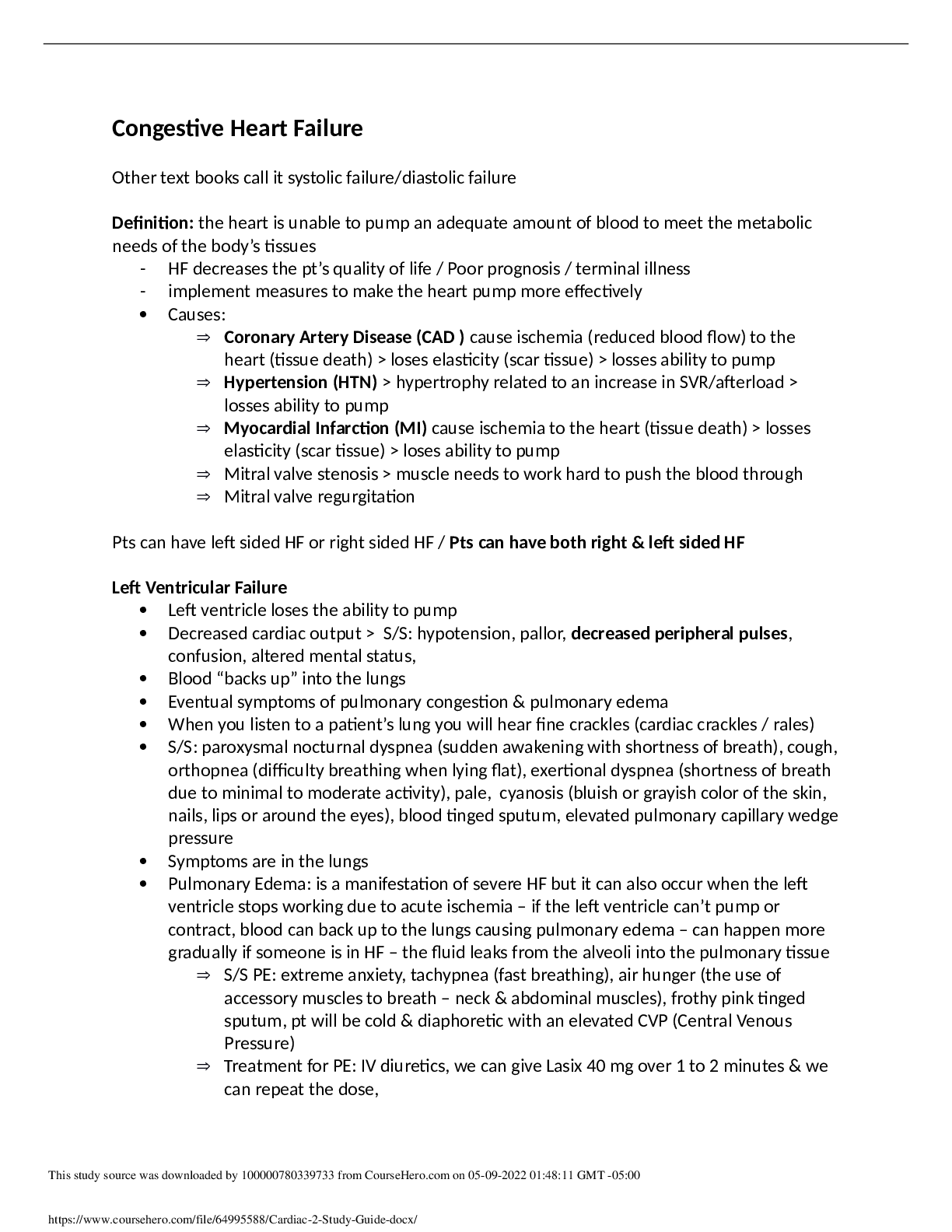Congestive Heart Failure
Other text books call it systolic failure/diastolic failure
Definition: the heart is unable to pump an adequate amount of blood to meet the metabolic
needs of the body’s tissues
- HF decreases the pt’s quality of life / Poor prognosis / terminal illness
- implement measures to make the heart pump more effectively
Causes:
Coronary Artery Disease (CAD ) cause ischemia (reduced blood flow) to the
heart (tissue death) > loses elasticity (scar tissue) > losses ability to pump
Hypertension (HTN) > hypertrophy related to an increase in SVR/afterload >
losses ability to pump
Myocardial Infarction (MI) cause ischemia to the heart (tissue death) > losses
elasticity (scar tissue) > loses ability to pump
Mitral valve stenosis > muscle needs to work hard to push the blood through
Mitral valve regurgitation
Pts can have left sided HF or right sided HF / Pts can have both right & left sided HF
Left Ventricular Failure
Left ventricle loses the ability to pump
Decreased cardiac output > S/S: hypotension, pallor, decreased peripheral pulses,
confusion, altered mental status,
Blood “backs up” into the lungs
Eventual symptoms of pulmonary congestion & pulmonary edema
When you listen to a patient’s lung you will hear fine crackles (cardiac crackles / rales)
S/S: paroxysmal nocturnal dyspnea (sudden awakening with shortness of breath), cough,
orthopnea (difficulty breathing when lying flat), exertional dyspnea (shortness of breath
due to minimal to moderate activity), pale, cyanosis (bluish or grayish color of the skin,
nails, lips or around the eyes), blood tinged sputum, elevated pulmonary capillary wedge
pressure
Symptoms are in the lungs
Pulmonary Edema: is a manifestation of severe HF but it can also occur when the left
ventricle stops working due to acute ischemia – if the left ventricle can’t pump or
contract, blood can back up to the lungs causing pulmonary edema – can happen more
gradually if someone is in HF – the fluid leaks from the alveoli into the pulmonary tissue
S/S PE: extreme anxiety, tachypnea (fast breathing), air hunger (the use of
accessory muscles to breath – neck & abdominal muscles), frothy pink tinged
sputum, pt will be cold & diaphoretic with an elevated CVP (Central Venous
Pressure)
Treatment for PE: IV diuretics, we can give Lasix 40 mg over 1 to 2 minutes & we
can repeat the dose,
This study source was downloaded by 100000780339733 from CourseHero.com on 05-09-2022 01:48:11 GMT -05:00
https://www.coursehero.com/file/64995588/Cardiac-2-Study-Guide-docx/
When pt’s go into PE: one of the first things to do is sit them way up in fowler’s
position, put them on oxygen, get their oxygen saturation, sometimes we need to
draw their blood gases & we can also give morphine 2mg to 5 mg IV push
(decreases afterload but especial preload – dilates arteries & veins)
We can cause venous dilation, so less blood is going to the right side of the heart,
b/c when it’s done with the right side it goes to the lungs
Keep in mind that pts with PE: may need to be intubated
Read More


